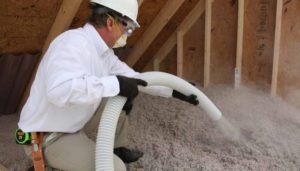 Have you heard of TAP insulation? Recently, the government passed a tax credit to refund home owners a percentage of their investment when purchasing this product for their homes.
Have you heard of TAP insulation? Recently, the government passed a tax credit to refund home owners a percentage of their investment when purchasing this product for their homes.
But what is it and why should you invest in it?
TAP Pest Control Insulation boasts multiple benefits and is a cost-effective improvement you can make to your home. It’s the only product that has been registered with the U.S. Environmental Protection Agency to control pests while also having an Energy Star label and UL Classification.
What does that mean for you as a homeowner?
It can help you prevent and eliminate the spread of potentially disease-causing pests like cockroaches and termites while simultaneously saving you money on energy.
If you’re a budget-conscious homeowner, you’ll be thrilled. Here’s what you need to know about TAP insulation.
What is TAP?
TAP stands for Thermal Acoustical Pest Control Insulation. The insulation is composed of interconnecting paper fibers which are installed in the attic to help reduce sounds and regulate the temperature inside buildings. A layer of borate material is added to the fibers which actively helps to kill pests that come into contact with it.
Benefits
Thermal Insulation Saves on Energy Bill
A major benefit are the savings which come as a result of the installation. TAP acts like a blanket for your home as the cellulose fibers interconnect to create an almost perfect degree of insulation. It’s light enough to keep heat trapped while being dense enough to prevent air flow. Homeowners can save up to 30% on their energy bill yearly!
Eliminate Outdoor Sounds
Do noises bother you? Would you like to create a quiet sanctuary at home? TAP Pest Control Insulation is highly effective at cutting down on the noise that often comes in through the ceiling of your home. How? Sound flows through solid materials just as easily as heat does. For this reason, the small air pockets found in the interconnecting fibers in the insulation can reduce the amount of noise being transmitted. When installed in the ceiling at a level of R-60, especially across your attic, typical outdoor sounds are almost 100% eliminated!
Keep Pests Out
On top of thermal and acoustical benefits, TAP Pest Control Insulation acts as an active form of pesticide for your attic space. How does it keep pests out? A unique borate material is added to the paper fibers to eliminate bugs. You may have heard of the material as it’s also commonly found in cabinets, baseboards of homes, and even on the perimeters of homes.
The producers add this borate material onto paper fibers during the manufacturing process. Paper fibers are naturally adhesive, which allows for the borate particles to stick to the fiber lightly, distributing them evenly all throughout the insulation. Once insects come in contact with borate, the particles attach to them. Ultimately, the insects ingest the particles as they groom themselves, disrupting their digestive process, and starving them to death.
This helps to reduce the amount of pests that make it into your living space, as well as preventing any from nesting in your attic.
Dugas Provides TAP Pest Control Insulation
Dugas Pest Control is now offering to install TAP Pest Control Insulation safely and professionally in your home. Not only will you be able to benefit from the multipurpose uses of TAP, but you will also be able to take advantage of the tax credit through Dec 31, 2016. Contact us today to schedule your appointment!

 Winter is upon us which means we start up the fireplace and enjoy some time indoors. The unfortunate part, we’re not the only ones who enjoy doing so! Pests are drawn to the warmth and refuge of our homes, finding their way in through cracks and holes under sills, around the foundation, and along eaves.
Winter is upon us which means we start up the fireplace and enjoy some time indoors. The unfortunate part, we’re not the only ones who enjoy doing so! Pests are drawn to the warmth and refuge of our homes, finding their way in through cracks and holes under sills, around the foundation, and along eaves. Although not always a requirement, having a house checked for termites is an extremely good idea, especially when the house is in the process of being sold. As a realtor, you have probably witnessed a few cases where problems were uncovered after a sale goes through… and it can be ugly.
Although not always a requirement, having a house checked for termites is an extremely good idea, especially when the house is in the process of being sold. As a realtor, you have probably witnessed a few cases where problems were uncovered after a sale goes through… and it can be ugly.